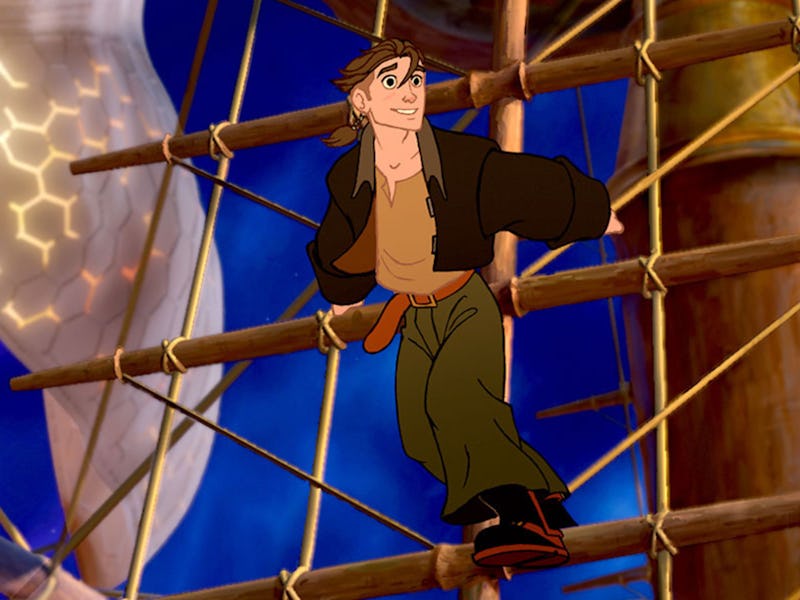Treasure Planet was a box office failure, but 20 years later, it found its audience
When you crunch the numbers, there’s no way to consider it anything but a failure.

At first glance, it’s hard to understand why Treasure Planet was a box office failure. Released on November 27, 2002, the concept for this Disney animated adventure certainly sounds intriguing: take Robert Louis Stevenson’s classic pirate novel, give it a sci-fi edge, and set it in space. Who doesn’t love space pirates?
Add some big names to the voice actor roster (Joseph Gordon-Levitt, Emma Thompson, David Hyde Pierce, and Brian Murray) plus some spectacular animation, and Disney should have had a guaranteed hit. In fact, it even earned a nomination for Best Animated Feature Film — but lost to Spirited Away.
Still, when you crunch the numbers, there’s no way to consider Treasure Planet anything but a failure. Treasure Planet cost $140 million to make and only earned $109 million. It also received mixed reviews and hovers just above “rotten” territory on Rotten Tomatoes.
Since its release, Treasure Planet has become something of a cult classic, especially among nostalgic Millenials, but its failure at the box office only illustrates an unfortunate trend that changed Disney and animation in general in the early 2000s.
The story behind Treasure Planet begins 17 years before the film’s release. Longtime Disney directors Ron Clements and John Musker came up with the concept but struggled to pitch it to the studio. Initially, they pitched it alongside The Little Mermaid (you can probably guess which one got the green light).
After the success of Little Mermaid, Clements and Musker pitched Treasure Planet several more times — usually right after the success of something else. But they didn’t get approval until their contracts came up for renewal in 1995, and they threatened to leave. Finally, the duo got their passion project.
The film beautifully blends the two animation styles to create breathtaking imagery.
Twenty years later, what stands out most about Treasure Planet is its uniquely beautiful animation. The film mixes hand-drawn cartoons with what was then cutting-edge CGI.
This wasn’t the first time a movie mixed these two styles, but it works particularly well in Treasure Planet’s sci-fi setting. The movie’s futuristic steampunk world comes to life, and the characters are no different.
John Silver’s design impressively uses both animation styles with a hand-drawn human(ish) body and computer-animated cybernetic parts. Credit goes to the drawing skills of Glen Keane (son of Family Circus cartoonist Bill Keane) and the computer animation of Eric Daniels, who worked together to bring the character to life.
John Silver is the only character in the film designed using both hand-drawn animation and CGI.
As for the story, Treasure Planet mostly retains the integrity of the source material, and any changes Clements and Musker do make all serve the plot well. Protagonist Jim Hawkins is aged up to a teenage rebel without a cause. He’s angry, frustrated, lost, and resentful of the father who abandoned him.
(Absent parents are nothing new to Disney, but active hostility toward said parent is less common. That’s a surprisingly more mature topic for a kids’ film.)
The central relationship is the father-son bond that develops between John Silver and Jim, who finds encouragement from the pirate that he never received from his distant father. Throughout the story, become more responsible and confident, while Silver gains the capacity to care about another person.
While Silver is technically a villainous character, he ultimately comes through for Jim. Silver does commit some truly heinous acts (that he’s definitely not repentant for), but oddly enough, there’s no comeuppance for the pirate in the end. John Silver might not be an “anti-hero,” but by Disney cartoon standards, he’s about as morally complex as they get.
Things take a bad turn on Treasure Planet for Jim and Silver.
There’s no one clear reason why Treasure Planet flopped at the box office. Some speculate it could be the release date, which overlapped with Harry Potter and the Chamber of Secrets and sunk the less recognizable IP. The film’s marketing also struggled to find its audience, aiming at kids with what still feels like a more mature Disney entry. And it’s likely those mature themes also dissuaded some parents from bringing their kids to see it at all.
But perhaps most notably, Treasure Planet represents an era where hand-drawn animation declined, and cheaper CGI became the norm. While this movie attempted to bridge the gap, it was ultimately held back by a world that was more excited about the future than nostalgic for the past. In the decades that followed, Disney leaned hard into computer animation, leading to mega-hits like Frozen, Zootopia, and Encanto.
Jim riding his rocket-powered sailboard.
Treasure Planet’s box office failure may have been the nail in the coffin for hand-drawn cartoons (at least at Disney). The studio even halted plans for a sequel, though perhaps it’s a good thing we never got a half-baked straight-to-VHS Treasure Planet 2.
Still, we can’t help but wonder what would have happened if Ron Clements and John Musker got to make their space pirate adventure back in the ‘80s. In that alternate reality, perhaps Disney is producing a live-action Treasure Planet remake right now.
Then again, maybe it’s best to leave history unchanged on this one.
This article was originally published on